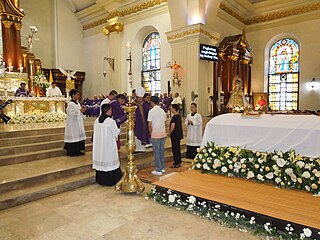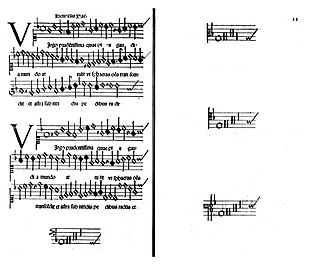
The Immaculate Conception is the belief that the Virgin Mary was free of original sin from the moment of her conception. It is one of the four Marian dogmas of the Catholic Church. Debated by medieval theologians, it was not defined as a dogma until 1854, by Pope Pius IX in the papal bull Ineffabilis Deus. While the Immaculate Conception asserts Mary's freedom from original sin, the Council of Trent, held between 1545 and 1563, had previously affirmed her freedom from personal sin.

An antiphon is a short chant in Christian ritual, sung as a refrain. The texts of antiphons are usually taken from the Psalms or Scripture, but may also be freely composed. Their form was favored by St Ambrose and they feature prominently in Ambrosian chant, but they are used widely in Gregorian chant as well. They may be used during Mass, for the Introit, the Offertory or the Communion. They may also be used in the Liturgy of the Hours, typically for Lauds or Vespers.

Maurice Gustave Duruflé was a French composer, organist, musicologist, and teacher.

The Hail Mary or Angelical salutation is a traditional Catholic prayer addressing Mary, the mother of Jesus. The prayer is based on two biblical passages featured in the Gospel of Luke: the Angel Gabriel's visit to Mary and Mary's subsequent visit to Elisabeth, the mother of John the Baptist. It is also called the Angelical Salutation, as the prayer is based on the Archangel Gabriel's words to Mary. The Hail Mary is a prayer of praise for and of petition to Mary, regarded as the Theotokos. Since the 16th century, the version of the prayer used in the Catholic Church closes with an appeal for her intercession. The prayer takes different forms in various traditions and has often been set to music.

A Requiem or Requiem Mass, also known as Mass for the dead or Mass of the dead, is a Mass of the Catholic Church offered for the repose of the soul or souls of one or more deceased persons, using a particular form of the Roman Missal. It is usually celebrated in the context of a funeral.
"Tantum ergo" is the incipit of the last two verses of Pange lingua, a Medieval Latin hymn generally attributed to St Thomas Aquinas c. 1264, but based upon various earlier fragments. The "Genitori genitoque" and "Procedenti ab utroque" portions are adapted from Adam of Saint Victor's sequence for Pentecost. The hymn's Latin incipit literally translates to "Therefore so great".

The "Salve Regina", also known as the "Hail Holy Queen", is a Marian hymn and one of four Marian antiphons sung at different seasons within the Christian liturgical calendar of the Catholic Church. The Salve Regina is traditionally sung at Compline in the time from the Saturday before Trinity Sunday until the Friday before the first Sunday of Advent. The Hail Holy Queen is also the final prayer of the Rosary.
Grzegorz Gerwazy Gorczycki was a Polish Baroque composer. Considered one of the greatest composers of Polish Baroque music, during his lifetime he was called the "Polish Handel".

José Maurício Nunes Garcia was a Brazilian classical composer, one of the greatest exponents of Classicism in the Americas.
Robert White probably born in Holborn, a district of London, was an English composer whose liturgical music to Latin texts is considered particularly fine. His surviving works include a setting of verses from Lamentations, and instrumental music for viols.

The Requiem, Op. 9, is a 1947 setting of the Latin Requiem by Maurice Duruflé for a solo baritone, mezzo-soprano, mixed choir, and organ, or orchestra with organ. The thematic material is mostly taken from the Mass for the Dead in Gregorian chant. The Requiem was first published in 1948 by Durand in an organ version.
"Libera me" is a responsory sung in the Office of the Dead in the Catholic Church, and at the absolution of the dead, a service of prayers for the dead said beside the coffin immediately after the Requiem Mass and before burial. The text asks God to have mercy upon the deceased person at the Last Judgment.

"In paradisum" is an antiphon from the traditional Latin liturgy of the Western Church Requiem Mass. It is sung by the choir as the body is being taken out of the church. The text of the In paradisum — with or without the Gregorian melody itself — is sometimes included in musical settings of the Requiem Mass, such as those by Gabriel Fauré and by Maurice Duruflé.

The Order of the Immaculate Conception, abbreviated OIC and also known as the Conceptionists, is a Catholic religious order of Pontifical Right for nuns founded by Saint Beatrice of Silva. For some years, they followed the Poor Clares Rule, but in 1511 they were recognized as a separate religious order, taking a new rule and the name of Order of the Immaculate Conception.
"Ubi caritas" is a hymn of the Western Church, long used as one of the antiphons for the washing of feet on Maundy Thursday. Its text is attributed to Paulinus of Aquileia in 796. The traditional melody probably also stems from the late 8th century. It is now and then sung at Eucharistic Adoration and Benediction of the Blessed Sacrament and has for a long time been part of the Holy Thursday evening liturgy. The current Roman Catholic Missal reassigned it from the foot-washing mandatum to the offertory procession at the Holy Thursday evening Mass of the Lord's Supper. It also is found in current Anglican and Lutheran hymnals.
The Music for the Requiem Mass is any music that accompanies the Requiem, a Mass in the Catholic Church for the deceased. It has inspired a large number of compositions, including settings by Mozart, Berlioz, Donizetti, Verdi, Bruckner, Saint-Saëns, Dvořák, Fauré and Duruflé. Originally, such compositions were meant to be performed in liturgical service, with monophonic chant. Eventually the dramatic character of the text began to appeal to composers to an extent that they made the requiem a genre of its own, and the compositions of composers such as Verdi are essentially concert pieces rather than liturgical works.

Tota pulchra es, WAB 46, is a sacred motet by the Austrian composer Anton Bruckner.

Ave Maria, WAB 6, is a sacred motet by Anton Bruckner, a setting of the Latin prayer Ave Maria. He composed it in Linz in 1861 and scored the short work in F major for seven unaccompanied voices. The piece, sometimes named an Offertorium, was published in Vienna in 1867. Before, Bruckner composed the same prayer in 1856 for soprano, alto, a four-part mixed choir, organ and cello, WAB 5. Later, he set the text in 1882 for a solo voice (alto) and keyboard, WAB 7.

Quatre Motets sur des thèmes grégoriens, Op. 10, are four sacred motets composed by Maurice Duruflé in 1960, based on Gregorian themes. He set Ubi caritas et amor, Tota pulchra es, Tu es Petrus and Tantum ergo.

Virgo prudentissima is a six-voice motet (SSAATB), dedicated to the Virgin Mary and composed by Heinrich Isaac in 1507. The motet describes the Assumption of Mary, calling on her and the nine orders of angels to protect Emperor Maximilian I and the Holy Roman Empire. The lyricist was Georg von Slatkonia.













